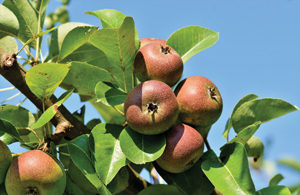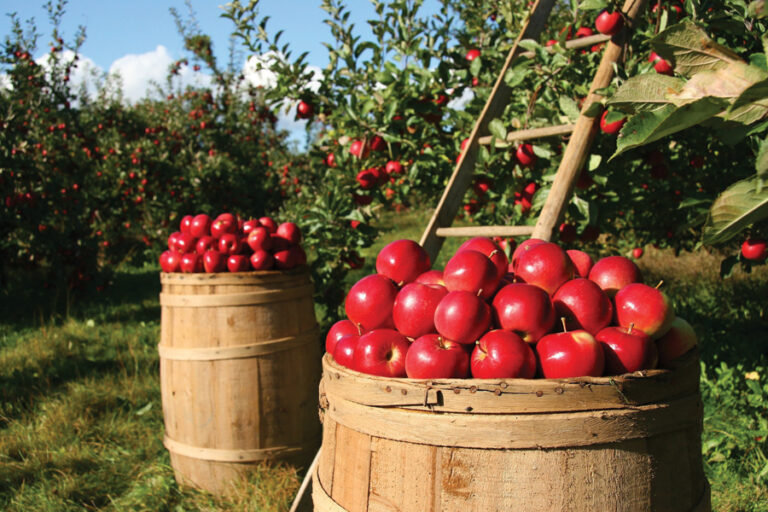If there’s just one type of fruit tree that you might consider for your garden, let it be an apple. A tree that almost guarantees fruit success, whatever the weather. Malus are well suited to the UK climate, including the wettest or hottest summer, and the coldest winter. What’s more, apple trees can tolerate most types of soil and are troubled by very few pests and diseases.
These fine trees are an asset to any garden, providing spring blossom, dappled shade, biodiversity, beauty and, of course, fruit at the end of the summer and into autumn.
Which apple?
The most difficult task is to select a variety out of around 2,500 that exist in the UK. When you consider the lack of choice within most supermarkets, growing your own is liberating for the taste buds!
There are a number of factors to consider:
• Do you want an apple for cooking or a dessert apple to eat straight off the tree?
• Flavour is one of the most important considerations. Some apples are sweet and juicy, and others are tart. They might have a hint of honey, or be aromatic or subtle. Some apples are slightly nutty and feel dry in the mouth. At a time of year when the harvest is in full swing, there could be an opportunity for apple-tasting at farm shops and orchards across the country. It’s a great opportunity to find a favourite.
 • The appearance of the apple might be important to you. There are rosy red apples, lime-green fruits, golden yellow globes, fruits with bronze tones and others with a combination of colours. All beautiful in their own right.
• The appearance of the apple might be important to you. There are rosy red apples, lime-green fruits, golden yellow globes, fruits with bronze tones and others with a combination of colours. All beautiful in their own right.
• Cropping time might also affect your choice. Some apples ripen early in the season and others much later.
• Think about pollination: it is vital if the apple tree is to produce fruit. You will need a different type of apple nearby for cross-pollination unless you choose a self-fertile tree.
• Consider the storage capability of the fruit. Many varieties of apples will store for several weeks or even months, in appropriate conditions. Others have only a brief shelf life and need to be eaten fairly promptly.
Rootstocks
The ultimate size of the tree is important too, especially if you have a small garden. This, however, shouldn’t restrict your choice of variety because it’s all about the rootstock.
The majority of apple trees are grafted onto a specific rootstock which will control the vigour of the tree. The tiniest tree will probably have the M27 rootstock, limiting the size to around 1.5m tall with a similar spread. This is also suitable for apples to be trained as ‘stepovers’. These trees measure only around 60cms high because they have been pruned to create horizontal branches that you can literally step over.
The M9 rootstock will enable an apple tree to grow up to 2.5m tall and M26 will give them a little more vigour so they can reach up to 3m high. These are often used for trees trained as espaliers, fans and cordons, so that they can be grown against a wall or fence.
The fascination of grafting has no bounds. It means you can even have what is known as a ‘family tree’, with several varieties of apples grafted onto just one tree.
Five fun facts
• Apples float because they are 25 per cent air. Ideal for apple bobbing!
• Apple juice is said to act as an antidepressant, partly because the fruit contains serotonin which helps to reduce anxiety.
• The seeds of an apple contain a compound that can turn into cyanide when chewed. This could be lethal in high doses. This might explain the story of Snow White who fell into a coma after biting the poisoned apple.
• The popular Granny Smith apple got its name from Maria Ann Smith in Sydney, Australia. It is thought that she had been cooking crab apples and throwing the cores out into her garden. Some grew into seedlings which eventually turned into trees bearing exceptional fruit.
• One of the most popular cooking apples is the Bramley. The very first one was planted by a child in Nottinghamshire, Mary Ann Brailsford, who took a pip from an apple being baked by her mother. It grew into a superb fruit-producing tree that was subsequently purchased with the house by a butcher, Matthew Bramley. When a local nurseryman asked if he could take cuttings from the tree, Bramley asked that the apples be given his name.
By Caroline Knight


